![]()
|
|
Alfred Meakin - The World's Largest Teapot
| > | The Alfred Meakin pottery company was established in 1875 in Tunstall, Stoke-on-Trent. |
| > | In the 1890's as part of their sales promotion in America they produced a limited number of giant teapots, all with different patterns. The teapots were 37 inches tall and 73 inches in circumference. |
| > | The name of the wholesaler the teapot was presented to was printed on in gold leaf. They were designed to be on display in the store to attract attention boost sales. |
| > | The teapots were featured in Ripley's Believe it or Not newspaper column as being able to serve 2,000 cups. This was an exaggeration - at 23 gallons capacity the teapot held about 700 - 850 cups of tea. |
| > |
Meakin probably created a dozen or so of these teapots and sent one to each
of the leading china wholesalers in the United States. Today only four are known to have survived:
Alfred Meakin also made large presentation jugs - only one is known:
|
- click for more on Alfred Meakin -
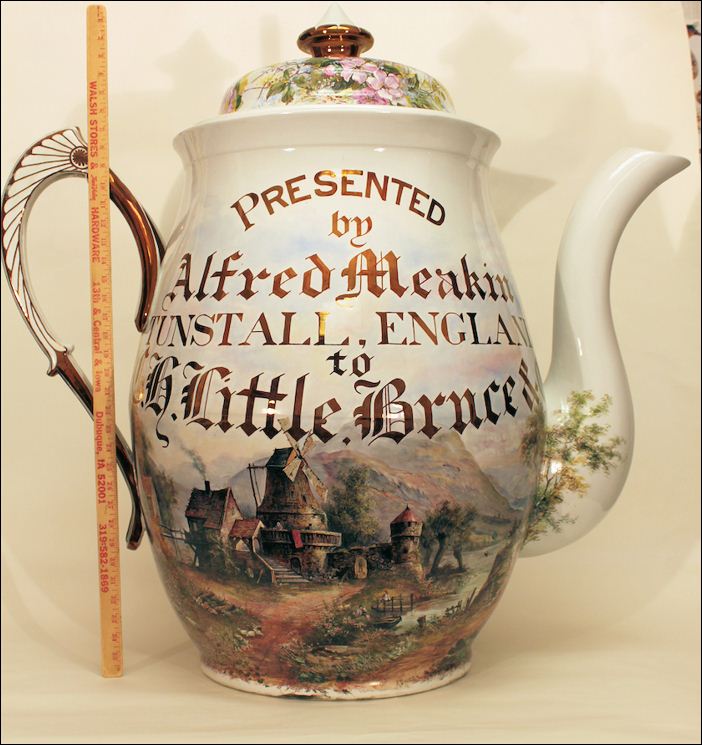
standing 3 foot high - the
Worlds Biggest Teapot
This display
teapot was made by Alfred Meakin of Tunstall, Stoke-on-Trent
and presented to C.H. Little, Bruce & Co.
currently (2014) on display at Hohnecker's Gifts in Dubuque, Iowa
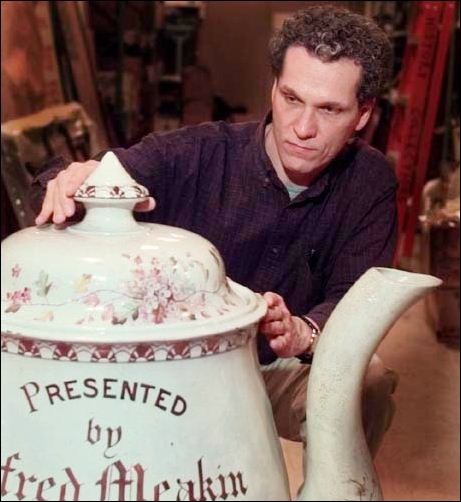
Cincinnati Museum Center's
Curator David Conzett
with the 23-gallon teapot which was originally presented in 1893 by Alfred
Meakin
to the Dean and Kite wholesale china company, Cincinnati , America
this photo illustrates the size of the giant teapot
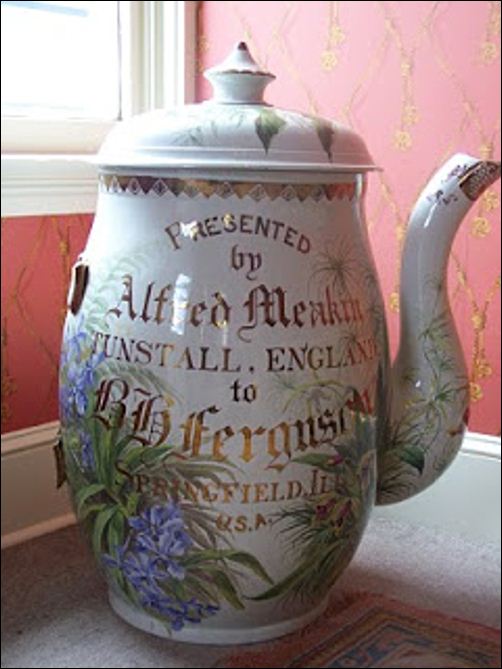
Presented
by Alfred Meakin Tunstall, England, to B H Ferguson, Springfield, Ills.
U.S.A.
| The teapot is 37 inches tall and 73 inches in circumference. It features hand-painted flowers and gold lustre lettering which proclaims "Presented by Alfred Meakin Tunstall, England, to B H Ferguson, Springfield, Ills. U.S.A." Somewhere along the way its handle was broken. |
|
Tea for Two—or Two Thousand 'If Alice’s “Wonderland” had taken in a little more territory, she might have found that, no matter to what size she grew or diminished, she could have a pot of tea in comfort. The problem could have been solved quite easily, right in our showroom in Dubuque where such vividly contrasted pieces as those shown in the illustration are to be found.
Each of the teapots was decorated in an entirely individualistic manner, and in luster lettering bore the inscriptions “Presented by Alfred Meakin, Tunstall, England” followed by the name of the recipient. The illustration shows something of the exquisite beauty of the decorations, each of which was handpainted by one of the various artists who were employed at that time by the factory. Such artists as A. Bourne, A. Capey, K. Kitteridge, and others were included in this group. The teapot which is on display in Becker-Hazleton Company’s booth at the Hardware Dealers Convention in Des Moines was presented to C.H. Little, Bruce & Co. which is the name by which the present Becker-Hazleton Company was then known. This teapot as decorated by A. Bourne who was one of the outstanding English artists of his time.
It is believed that this is one of very few of the teapots still in existence at the present time, and since the moulds were destroyed long ago, it is impossible for the factory to reproduce them. And their enormous size-they are between 36 and 37 inches in height, about the same from the tip of the spout to the edge of the handle, and 72 inches in circumference-presents almost insurmountable difficulties to the modern potter, who cannot devote the leisurely attention that was possible 50 years ago. The broad surfaces gave the artists an excellent opportunity to create such beautifully detailed designs as the formal garden scene which appears on the teapot illustrated here. A colorful fruit and flower pattern at the top of the pot, on the lide, and on the spout and a narrow band design at the edge line completes the decoration of this rare piece. The unusual character of the teapot always arouses a great deal of interest among those who see it in the showrooms. To the laymen, it is merely an exceptionally handsome curiosity. But to the potter, interest is centered largely in his knowledge of the infinite patience and expert care demand in its manufacture. He knows what a real feat it represented in potting, firing and glazing." description by Becker Hazelton c.1950 |
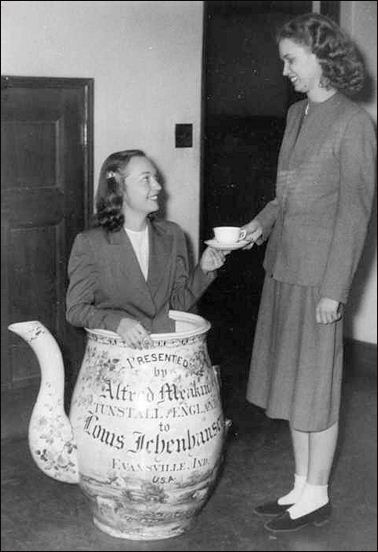
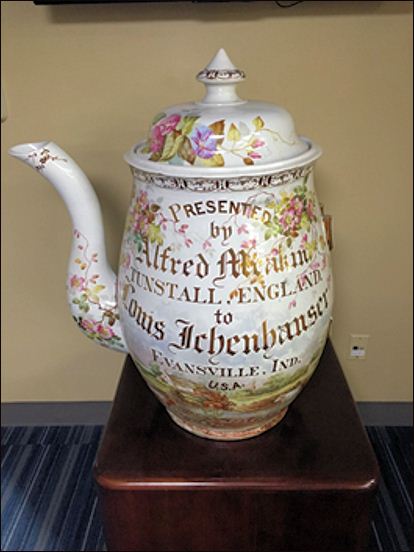
Presented
by Alfred Meakin Tunstall, England, to Louis Ichenhauser, Evansville, IND, USA
photos courtesy: Daniel Griffaton
The teapot is currently (2021) at the University of Evansville in Evansville,
Indiana - the display description reads....
|

The 30 inch (76cm) Sohm, Ricker & Weisenhorn presentation jug
Chipstone Foundation Collection. Photo by Gavin Ashworth
- click for more on Alfred Meakin -
Questions, comments, contributions? email: Steve Birks